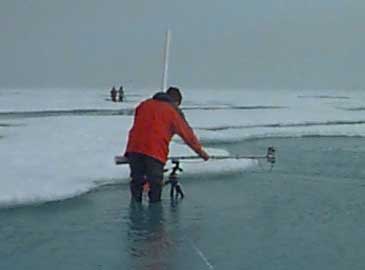
Albedo
Albedo (Al-bee-dough): the fraction of the incident sunlight that is reflected. When an object reflects most of the light that hits it, it looks bright and it has a high albedo. When an object absorbs most of the light that hits it, it looks dark. Dark objects have low albedos.
Measuring albedo is pretty easy. Instruments like the one in the picture have a sensor that measures how much light there is. We point the sensor upward to measure the incident sunlight, then quickly flip it upside down to measure the reflected sunlight. To get the albedo we divide the second measurement (reflected) by the first measurement (incident).In the Arctic, sometimes you're cold and sometimes you're wet.

0
The albedo of a perfectly
black object is zero.
1
The albedo of a perfectly
white object is one.
If a surface is perfectly absorbing, none of the sunlight is reflected, it looks black, and the albedo is 0.If a surface is perfectly reflecting, it reflects all the sunlight, it looks white and has an albedo of 1.
The albedo of any object is somewhere between zero and one. For example, pavement is more dark than light, so its albedo is closer to zero than to one. But bright things, like white paper and snow, have higher albedos.